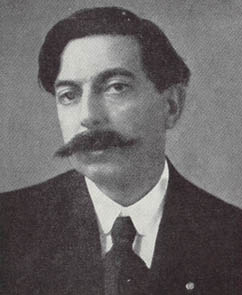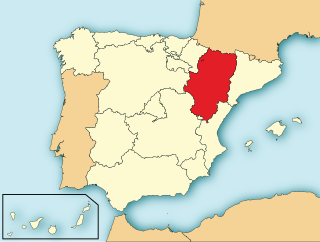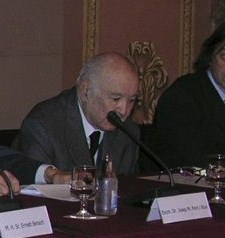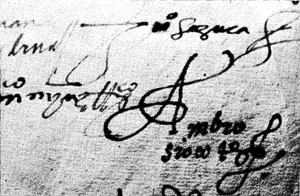Related Research Articles

Isaac Manuel Francisco Albéniz y Pascual was a Spanish virtuoso pianist, composer, and conductor. He is one of the foremost composers of the Post-Romantic era who also had a significant influence on his contemporaries and younger composers. He is best known for his piano works based on Spanish folk music idioms.

Johannes Ockeghem was the most famous composer of the Franco-Flemish School in the last half of the 15th century, and is often considered the most influential composer between Guillaume Dufay and Josquin des Prez. In addition to being a renowned composer, he was also an honored singer, choirmaster, and teacher.

Enrique Granados Campiña was a Spanish pianist and composer of classical music. His music is in a uniquely Spanish style and, as such, is representative of musical nationalism.

The Kingdom of Aragon was a medieval and early modern kingdom on the Iberian Peninsula, corresponding to the modern-day autonomous community of Aragon, in Spain. It should not be confused with the larger Crown of Aragon, that also included other territories — the Principality of Catalonia, the Kingdom of Valencia, the Kingdom of Majorca, and other possessions that are now part of France, Italy, and Greece — that were also under the rule of the King of Aragon, but were administered separately from the Kingdom of Aragon.
Nicolas Gombert was a Franco-Flemish composer of the Renaissance. He was one of the most famous and influential composers between Josquin des Prez and Palestrina, and best represents the fully developed, complex polyphonic style of this period in music history.

Antoine Busnois was a French composer and poet of the early Renaissance Burgundian School. While also noted as a composer of motets and other sacred music, he was one of the most renowned 15th-century composers of secular chansons. He was the leading figure of the late Burgundian school after the death of Guillaume Dufay.

Loyset Compère was a Franco-Flemish composer of the Renaissance. Of the same generation as Josquin des Prez, he was one of the most significant composers of motets and chansons of that era, and one of the first musicians to bring the light Italianate Renaissance style to France.

Claude Le Jeune was a Franco-Flemish composer of the late Renaissance. He was the primary representative of the musical movement known as musique mesurée, and a significant composer of the "Parisian" chanson, the predominant secular form in France in the latter half of the 16th century. His fame was widespread in Europe, and he ranks as one of the most influential composers of the time.

Francisco Bartolomé Sanz Celma, better known as Gaspar Sanz, was a Spanish composer, guitarist, organist and priest born to a wealthy family in Calanda in the comarca of Bajo Aragón, Spain. He studied music, theology and philosophy at the University of Salamanca, where he was later appointed Professor of Music. He wrote three volumes of pedagogical works for the baroque guitar that form an important part of today's classical guitar repertory and have informed modern scholars in the techniques of baroque guitar playing.
Luis de Narváez was a Spanish composer and vihuelist. Highly regarded during his lifetime, Narváez is known today for Los seys libros del delphín, a collection of polyphonic music for the vihuela which includes the earliest known variation sets. He is also notable for being the earliest composer for vihuela to adapt the contemporary Italian style of lute music.
Trebor was a 14th-century composer of polyphonic chansons, active in Navarre and other southwest European courts c. 1380-1400. He may be the same person also called Triboll, Trebol, and Borlet in other contemporaneous sources. His name is likely a reversal of Robert.
Cornelius Canis was a Franco-Flemish composer, singer, and choir director of the Renaissance, active for much of his life in the Grande Chapelle, the imperial Habsburg music establishment during the reign of Emperor Charles V. He brought the compositional style of the mid-16th century Franco-Flemish school, with its elaborate imitative polyphony, together with the lightness and clarity of the Parisian chanson, and he was one of the few composers of the time to write chansons in both the French and Franco-Flemish idioms.
Philippus de Caserta, also Philipoctus, Filipotto, or Filipoctus was a medieval music theorist and composer associated with the style known as ars subtilior.
Pedro Ruimonte was a Spanish composer and musician who spent much of his career in the Low Countries.

Martí de Riquer i Morera, 8th Count of Casa Dávalos was a Spanish–Catalan literary historian and Romance philologist, a recognised international authority in the field. His writing career lasted from 1934 to 2004. He was also a nobleman and Grandee of Spain.
Rocco Rodio was an Italian Renaissance composer and theorist, best known for his sacred works and keyboard ricercares.

Ambrosio Cotes was a Spanish Renaissance composer.
La mà de Guido is a Catalan music publishing house in Barcelona Spain founded in 1986 by the composer and musicologist Llorenç Balsach.

Founded in 1886 by Barcelona City Council, the Barcelona Municipal Band is a musical institution going back a long way. Since 2007, it has been the resident band at the Barcelona Auditorium (L'Auditori), where it offers a fixed season of concerts and where it develops projects in partnership with artists and groups forming part of the international scene as well as those from the local sphere. The resident conductor since 2008 has been the Catalan composer and conductor Salvador Brotons.
The Cancionero de Segovia or Cancionero Musical de Segovia (CMS), also known as Cancionero of the Segovia Cathedral, is a manuscript containing Renaissance music from the end of the 15th century and beginning of the 16th century. It contains a wide repertoire of works by mainly Spanish, French and Franco-Flemish composers. It is kept at the Segovia Cathedral Archives.
References
- ↑ Albert Ernest Wier The Macmillan encyclopedia of music and musicians 1938 Page 858 "Hykaert, Bernhard (Ycart), late 15th century Netherlands composer and theorist ; lived in Naples. His works included sacred and secular vocal pieces."
- ↑ Historia de la música española Tomo 2. Desde el ars nova hasta 1600. Samuel Rubio. Alianza Editorial. 1983.
- ↑ Lawrence F. Bernstein La Couronne et fleur des chansons a troys 1984 - Volume 3, Part 2 - Page 39 "appeared in the chanson "Non toches a moy" by Bernhard Ycart.62"
| This article about a Spanish composer is a stub. You can help Wikipedia by expanding it. |